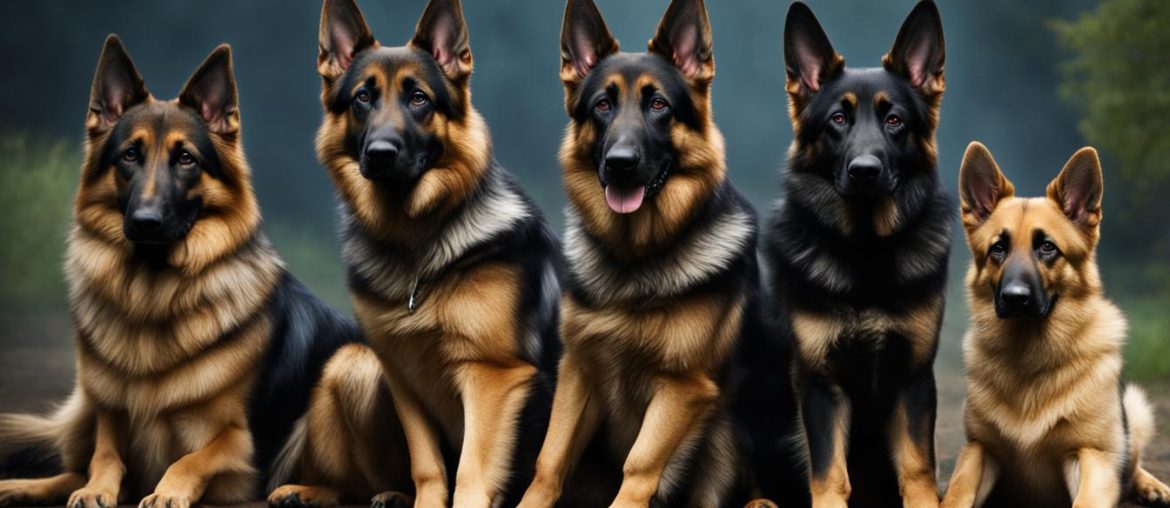German Shepherds are a popular and versatile breed known for their intelligence, loyalty, and versatility. However, many people may not be aware that there are various types of German Shepherds, each with its own unique characteristics and purposes. In this comprehensive guide, I will explore the different types of German Shepherds, their origins, physical traits, temperaments, and more.
Key Takeaways:
- German Shepherds come in different types, including show lines and working lines
- Each type has its own distinct characteristics, such as conformation, temperament, and purpose
- Coat colors can also vary among German Shepherds, with saddle-colored, black, white, and sable being common variations
- Understanding the different types of German Shepherds is essential to finding the right fit for your lifestyle and needs
- Whether you’re looking for a show line or a working line, there’s a German Shepherd breed that will be perfect for you
American Show Lines
American show lines are a popular variation of the German Shepherd breed in North America. These German Shepherds are specifically bred to conform to the standards set by the American Kennel Club (AKC). Show line breeders prioritize conformation and side gait, making these dogs well-suited for dog shows and conformation competitions.
American show lines typically have a black and tan coloration, with a distinct saddle pattern on their backs. Their coats are usually dense and medium in length. These German Shepherds are known for their friendly and approachable temperament, making them excellent family pets.
“American show lines are cherished for their beauty and graceful movement in the show ring. They are bred to showcase the breed’s elegance and adherence to breed standards defined by the AKC.”
If you’re considering an American show line German Shepherd, these dogs may have lower drive levels compared to working line German Shepherds. While they excel in the show ring, they may not have the same intensity and working capabilities as their working line counterparts. However, they can still participate in various dog sports and activities with proper training and socialization.
| Characteristic | American Show Lines |
|---|---|
| Appearance | Black and tan coloration with saddle pattern |
| Temperament | Friendly, approachable, and sociable |
| Main Purpose | Conformation shows and family companionship |
| Drive | Lower working drive compared to working line German Shepherds |
| Coat Length | Medium-length, dense coat |
Are American show lines right for you?
If you’re looking for a stunningly beautiful German Shepherd with a friendly disposition and a desire to compete in conformation shows, an American show line German Shepherd may be the perfect choice. They make loyal family pets and can be wonderful companions for individuals and families looking for a well-mannered and elegant dog.

To put it simply, I would advise that you choose a reputable breeder when considering an American show line German Shepherd. A responsible breeder will prioritize the health and temperament of their dogs while breeding for the desired conformation traits. Proper training, socialization, and regular exercise are also crucial for American show line German Shepherds to ensure they live a happy and fulfilling life.
Canadian Show Lines
Canadian show lines are a type of German Shepherd that adheres to the standards set by the Canadian Kennel Club. Similar to American show lines, Canadian show lines prioritize conformation and side gait, making them ideal for dog shows. They have a black and tan coloration, just like other show lines, and are known for their friendly temperament.
These Canadian show lines have been bred to meet the specific standards and requirements set by the Canadian Kennel Club. Their breeding focuses on producing dogs that excel in conformation competitions, emphasizing physical appearance and movement. This makes them well-suited for the show ring and highly sought after by show enthusiasts.
In addition to their appealing appearance, Canadian show lines are known for their friendly and approachable temperament. They are often considered great family pets due to their gentle nature and ability to get along well with people of all ages. These dogs tend to be social, outgoing, and enjoy being a part of family activities.
“Canadian show lines are a testament to the careful breeding practices and dedication to excellence that is characteristic of the German Shepherd breed. These dogs not only possess the distinctive physical traits expected of show lines, but also display the friendly and sociable temperament that makes them a beloved choice for families.”
If you’re looking for a German Shepherd that excels in conformation competitions and has a friendly, outgoing personality, a Canadian show line may be the perfect choice for you. These dogs combine beauty and charm, making them wonderful companions for both individuals and families.
| Traits | Canadian Show Lines |
|---|---|
| Coloration | Black and tan |
| Temperament | Friendly, outgoing |
| Main Purpose | Conformation competitions |
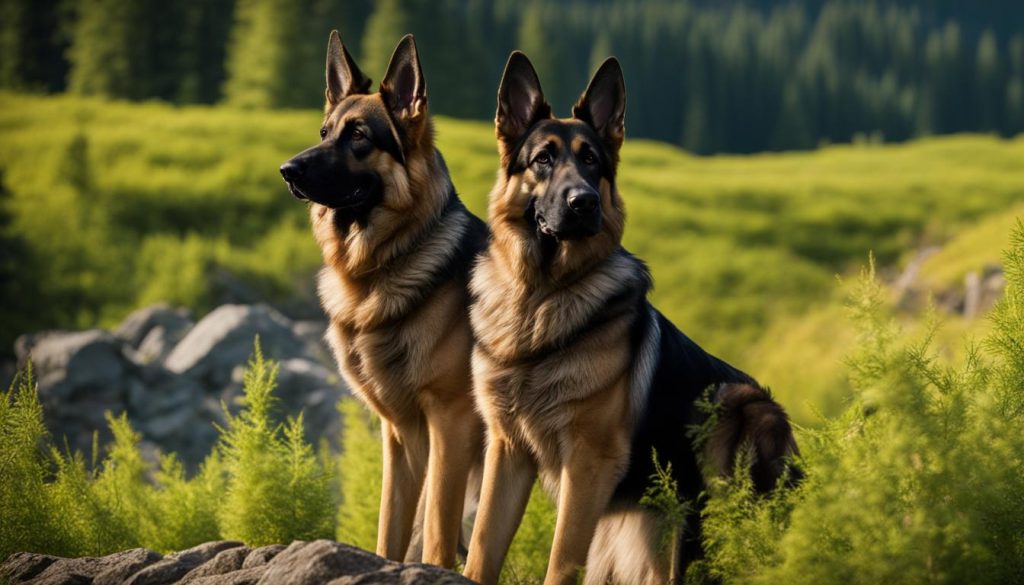
With their striking appearance and amiable temperament, Canadian show lines are a popular choice among German Shepherd enthusiasts and dog show enthusiasts alike. Their combination of beauty and personality makes them a standout in the world of German Shepherds.
West German Show Lines
West German show lines are one of the most prominent types of German Shepherds in Germany. These show lines conform to the standards set by the German Shepherd Dog Club of Germany (SV) and are highly regarded for their uniform appearance and adherence to health clearances and working titles. A signature characteristic of West German show lines is their distinctive black and red saddlebacks, which give them a striking and regal appearance.
These German Shepherds have a strong working heritage and are known for their versatility and trainability. They excel in various activities such as obedience trials, tracking, and agility competitions. Despite their focus on conformation and appearance, West German show lines also possess a sound temperament, making them suitable for families as well as working environments.
The West German show line German Shepherds are often bred for their drive, intelligence, and athleticism. They exhibit a strong desire to work and please their handlers, which makes them highly capable dogs in various working roles, including search and rescue, law enforcement, and service dog work. The West German show line German Shepherd is a testament to the breed’s versatility and adaptability.
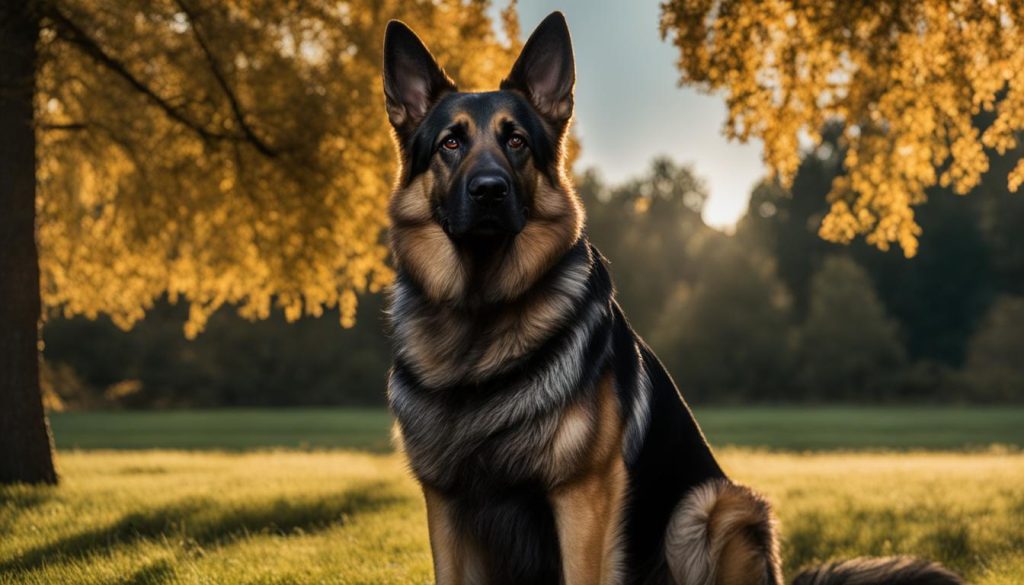
Notable Attributes of West German Show Lines:
- Distinctive black and red saddlebacks
- Uniform appearance
- Adherence to health clearances and working titles
- Versatility and trainability
- Strong working heritage
- Sound temperament
- Desire to work and please
| Characteristics | Details |
|---|---|
| Physical Appearance | Distinctive black and red saddlebacks |
| Temperament | Sound temperament suitable for families and working environments |
| Working Abilities | Highly capable in various working roles, including search and rescue, law enforcement, and service dog work |
| Trainability | Highly trainable and eager to work and please their handlers |
| Versatility | Excel in obedience trials, tracking, agility, and other activities |
| Health Clearances | Adherence to health clearances and working titles |
West German Working Lines
West German working lines of German Shepherds are highly sought after for their exceptional working abilities and strong temperament. These dogs are bred with a focus on correct working structure, making them ideal for various working roles, sports, and active families.
The West German working line German Shepherds excel in tasks that require agility, intelligence, and stamina. They are known for their high energy levels and strong drive to work, making them suitable for jobs such as search and rescue, police work, and competitive obedience. These dogs thrive in environments where they are given tasks to fulfill and require mental and physical stimulation.
The West German working line German Shepherds’ dedication and willingness to please make them highly trainable, and they form strong bonds with their handlers. Their solid temperament and natural protective instincts also make them excellent guard dogs and loyal family companions.
When compared to other types of German Shepherds, the West German working lines stand out for their exceptional working abilities, making them a preferred choice for those seeking dogs with a strong drive and purpose. You should note that the energetic nature and intense drive of these dogs require committed owners who can provide them with the necessary training, exercise, and mental stimulation they need to thrive.
| Characteristics | West German Working Lines |
|---|---|
| Temperament | Energetic, driven, intelligent, loyal, protective |
| Physical Appearance | Muscular, medium to large-sized, strong bone structure |
| Working Abilities | Agile, quick learner, excels in various working roles |
| Training | Highly trainable, forms strong bonds with handlers |
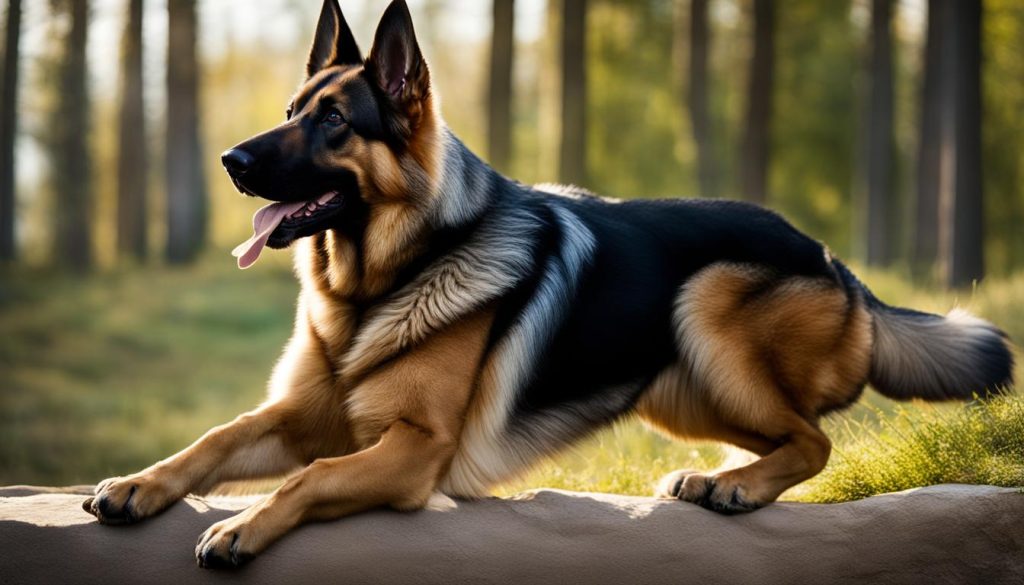
West German Working Lines: Key Points
- West German working lines are bred for their strong working abilities and correct working structure.
- They excel in various working roles, sports, and active family environments.
- These dogs have high energy levels and a strong drive to work, requiring dedicated owners who can provide them with the necessary training and mental stimulation.
- They are highly trainable, forming strong bonds with their handlers and making them excellent guard dogs and loyal family companions.
- The West German working lines have a distinct physical appearance, characterized by a muscular build and strong bone structure.
DDR/East German Working Lines
German Shepherds from DDR/East German working lines are a distinct type known for their correct working structure, large heads, large bone, and dark pigment. These dogs were developed in East Germany after World War II and have a rich history.
The DDR/East German working lines are bred with rigorous control of bloodlines, resulting in a unique look and sound temperament. They are highly valued for their genetics and temperament. These dogs are known for their loyalty, intelligence, and high drive to work. They excel in various working roles such as search and rescue, police work, and other demanding tasks.

Czech Working Lines
In the realm of German Shepherd variations, Czech working lines hold a prominent place. Originating in Czechoslovakia, these working lines were specifically bred from dogs used for border patrol work. They possess pretty good working abilities, agility, and high levels of drive. Czech working lines are widely favored by law enforcement agencies and individuals who participate in dog sports.
One of the distinguishing characteristics of Czech working lines is their intense working abilities. These dogs have been selectively bred for their exceptional focus, determination, and ability to excel in demanding tasks. Their high drive and energy make them well-suited for activities that require athleticism, such as obedience competitions, tracking, and protection work.
“Czech working lines are known for their intense drive and agility, making them a top choice for law enforcement and dog sport enthusiasts.”
In terms of appearance, Czech working lines often have a more compact and muscular build compared to other German Shepherd types. Their physical attributes contribute to their exceptional working capabilities. These dogs typically have a strong and confident presence, exuding an air of alertness and readiness.
| Key Features of Czech Working Lines | Characteristics |
|---|---|
| Working Abilities | High drive, intense focus, exceptional working performance |
| Appearance | Compact, muscular build with a strong and confident presence |
| Temperament | Assertive, bold, loyal |
| Suitability | Ideal for law enforcement, dog sports, and active individuals |
When it comes to temperament, Czech working lines are known for being assertive, bold, and fiercely loyal to their handlers. These dogs exhibit a strong sense of drive and determination, paired with unwavering loyalty. They form deep bonds with their owners and are highly protective.
To sum it up, Czech working lines are a type of German Shepherd that excels in working abilities, agility, and drive. Their compact build, intense focus, and assertive temperament make them a top choice for law enforcement agencies, as well as individuals involved in dog sports or seeking an active companion. With their exceptional working capabilities and unwavering loyalty, Czech working lines continue to be highly regarded within the German Shepherd breed.
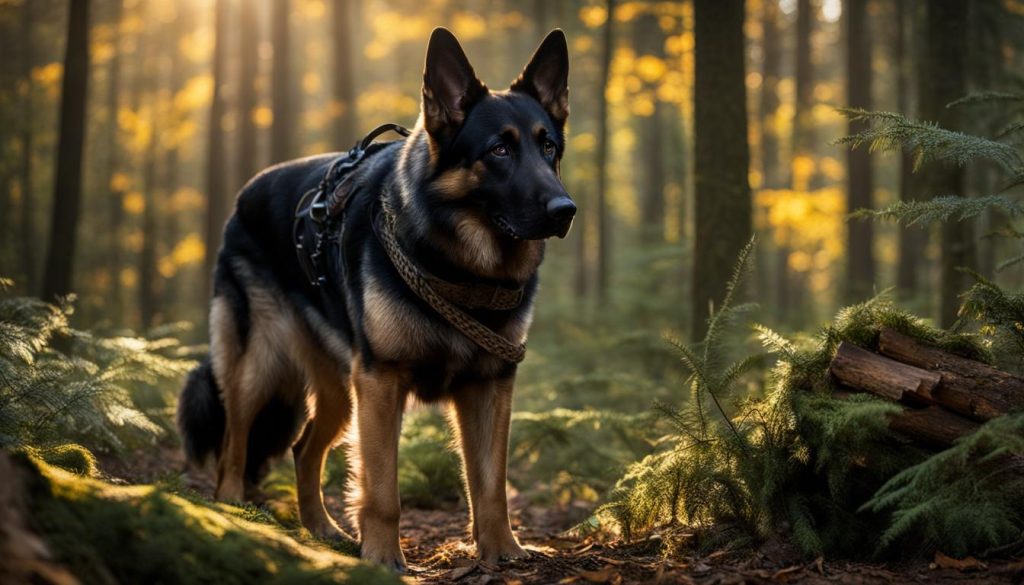
Various Mixes of Lines
German Shepherds are a versatile breed, and sometimes breeders mix different types of German Shepherds to create unique combinations. These mixes can offer a blend of physical attributes, temperaments, and working abilities from different lineages, resulting in dogs that can excel in various roles and environments.
When it comes to various mixes of German Shepherd lines, there are no set standards or specific traits that can be guaranteed. Each mix is unique and unpredictable, as it depends on the specific types of German Shepherds used in the breeding process. However, these mixes often inherit the best qualities from their parent breeds, creating dogs with a wide range of capabilities and characteristics.
For example, a mix between a West German working line and a DDR/East German working line may result in a dog that has the strong drives, athleticism, and working abilities from both lines. This mix could be an exceptional candidate for working roles such as search and rescue, police, or protection work. On the other hand, a mix between an American show line and a Canadian show line may produce a dog with a friendly temperament, stunning appearance, and the potential to excel in conformation shows.
while these mixes can offer a blend of desirable traits, it’s still crucial for potential owners to thoroughly research the specific lineage and individual dog to ensure it aligns with their needs and expectations. Consulting with reputable breeders and trainers can provide valuable insights into the characteristics of the mix and help guide the decision-making process.
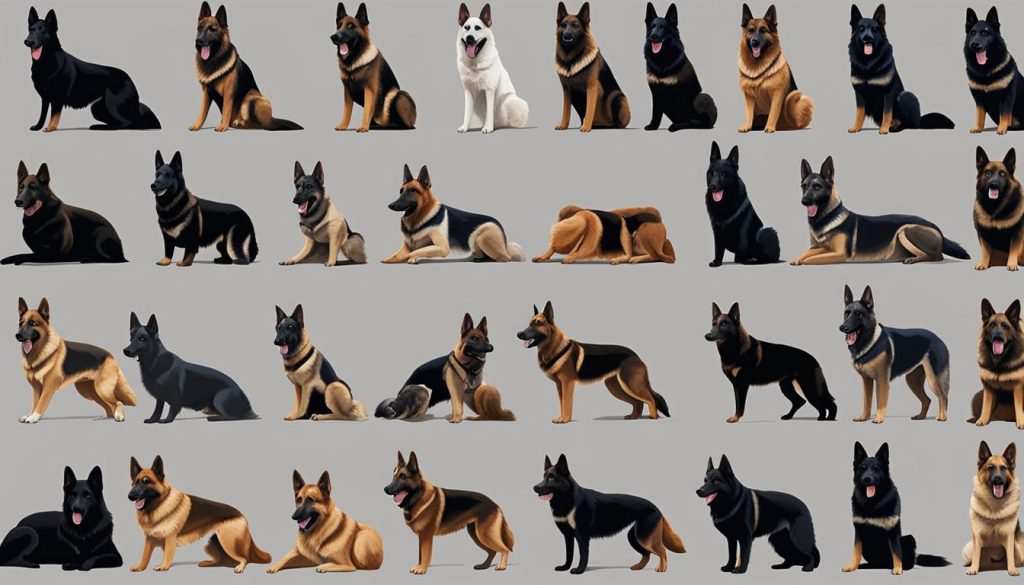
Frequently Asked Questions:
- Q: Are there any health concerns with mixed lines of German Shepherds?
A: Just like any other breed, be aware of potential health issues that can be prevalent in German Shepherds. However, by selecting responsible breeders who prioritize health testing and genetic screening, the risk of inheriting certain health conditions can be minimized.
- Q: Can mixed German Shepherds be good family pets?
- Q: How do I find a reputable breeder for mixed German Shepherds?
- Q: Can mixed German Shepherds inherit traits from both parent breeds?
A: Absolutely! The temperament and behavior of a mixed German Shepherd can vary depending on the specific mix and individual dog. Proper training, socialization, and providing a loving environment are key factors in raising a mixed German Shepherd as a well-rounded and loving family pet.
A: When looking for a breeder, do thorough research and seek recommendations from trusted sources such as local dog clubs or breed-specific organizations. Reputable breeders will prioritize the health and well-being of their dogs, provide proper documentation, and be willing to answer any questions you may have.
A: Yes, mixed German Shepherds can inherit traits from both parent breeds. However, remember that each individual dog is unique and may exhibit a combination of traits or favor one parent’s traits more than the other.
By considering various mixes of German Shepherd lines, potential owners can explore a broader range of options and find a dog that meets their specific needs and preferences. Whether it’s a mix of show lines, working lines, or a combination of both, these mixes can offer unique and exceptional companions for those willing to invest time, effort, and love into their care.
Working Line vs. Show Line German Shepherd
When considering a German Shepherd as a companion or working dog, understand the differences between working line and show line German Shepherds. These two types have distinct characteristics in terms of behavior, health, and purpose.
Working line German Shepherds are bred for their working abilities and are typically stronger, more energetic, and require a significant investment of time and energy. They excel in tasks such as search and rescue, police work, and competitive dog sports. Their high drive and intense focus make them well-suited for jobs that require athleticism and mental agility.
“Working line German Shepherds have a natural instinct for obedience and protection. They are highly trainable and have an innate desire to work and please their handlers.”
Show line German Shepherds, on the other hand, are bred for their conformation and are more suitable for dog shows and as family pets. They have a friendlier temperament and require less time commitment in terms of exercise and mental stimulation. Show line German Shepherds are known for their beauty, calm demeanor, and ability to interact well with children and other pets.
I recommend that you consider the specific traits and requirements of each type when choosing a German Shepherd. Working line German Shepherds generally have a lower risk of genetic health problems compared to show line German Shepherds, due to the rigorous selection process and focus on working ability. However, both types can make wonderful companions and can be trained to excel in various roles.
| Working Line German Shepherd | Show Line German Shepherd |
|---|---|
| Stronger and more energetic | Friendly and calm temperament |
| Requires significant exercise and mental stimulation | Requires less exercise and mental stimulation |
| Well-suited for working tasks and sports | Well-suited as family pets and for dog shows |
| Lower risk of genetic health problems | Potential for genetic health issues |
Ultimately, whether you choose a working line or show line German Shepherd depends on your lifestyle, preferences, and the specific role you envision for your dog. Both types have their own unique qualities and can bring joy, loyalty, and companionship to your life.
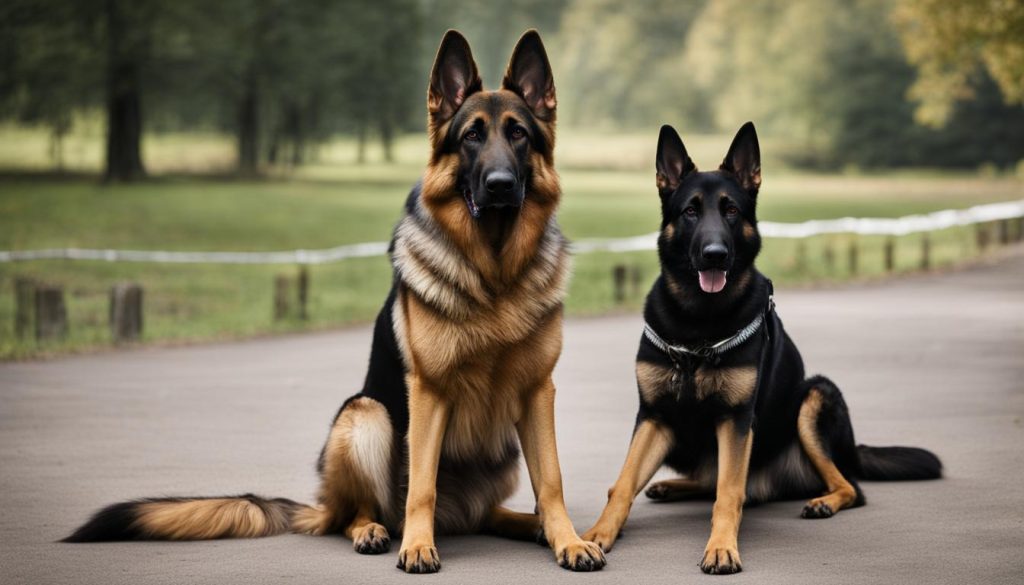
German Shepherd Behavior and Health
German Shepherds, regardless of working or show line, are intelligent and loyal dogs. They are known for their protective instincts, trainability, and versatility. Proper socialization, training, and ongoing mental and physical stimulation are essential for their well-being.
In terms of health, German Shepherds are prone to certain genetic health issues, such as hip dysplasia and degenerative myelopathy. Regular veterinary check-ups, a balanced diet, and maintaining a healthy weight can help mitigate these risks. Working line German Shepherds often have better overall health due to the rigorous breeding standards and emphasis on working ability.
To put it simply, whether you choose a working line or show line German Shepherd, investing time and effort into their training and care will result in a well-behaved and happy companion.
Types Based on Coat Color
German Shepherds are known for their beautiful and distinctive coat colors. These colors can vary and add to the uniqueness and appeal of the breed. Let’s explore some of the different coat colors that German Shepherds can have:
Saddle Colored German Shepherds
Saddle colored German Shepherds have a unique coat pattern that consists of a tan or red color with a black saddle or blanket pattern on their back. This pattern resembles a saddle, which is where their name comes from. The saddle can vary in size and intensity, giving each dog a distinct appearance. The rest of their body is usually tan or a lighter shade of the saddle color. Saddle colored German Shepherds are one of the most popular coat variations and are highly sought after by enthusiasts.
Black German Shepherds
Black German Shepherds have a solid black coat throughout their body. While the coat may appear entirely black, some black German Shepherds can have variations such as liver or blue in their coats. These variations add a unique touch to their appearance. Black German Shepherds are known for their striking presence and are often associated with elegance and strength.
White German Shepherds
White German Shepherds are rare and have a solid white coat. Their coat color is a result of a recessive gene and is not typically considered a standard color for the breed. White German Shepherds have become increasingly popular in recent years due to their stunning and distinct appearance. They are known for their intelligence, loyalty, and gentle nature.
Sable German Shepherds
Sable German Shepherds have a unique color pattern spread throughout their body. Their coat starts as tan and gradually becomes stronger and darker as they age. The color variation gives each dog a beautiful and eye-catching appearance. Sable German Shepherds are known for their versatility and are often seen in working lines due to their exceptional drives and abilities.
German Shepherds come in various coat colors, each with its own charm and characteristics. Whether you prefer the classic saddle color, the elegance of black, the rarity of white, or the unique pattern of sable, there is a coat color that will capture your heart. Each coat color adds to the overall beauty and individuality of the German Shepherd breed.
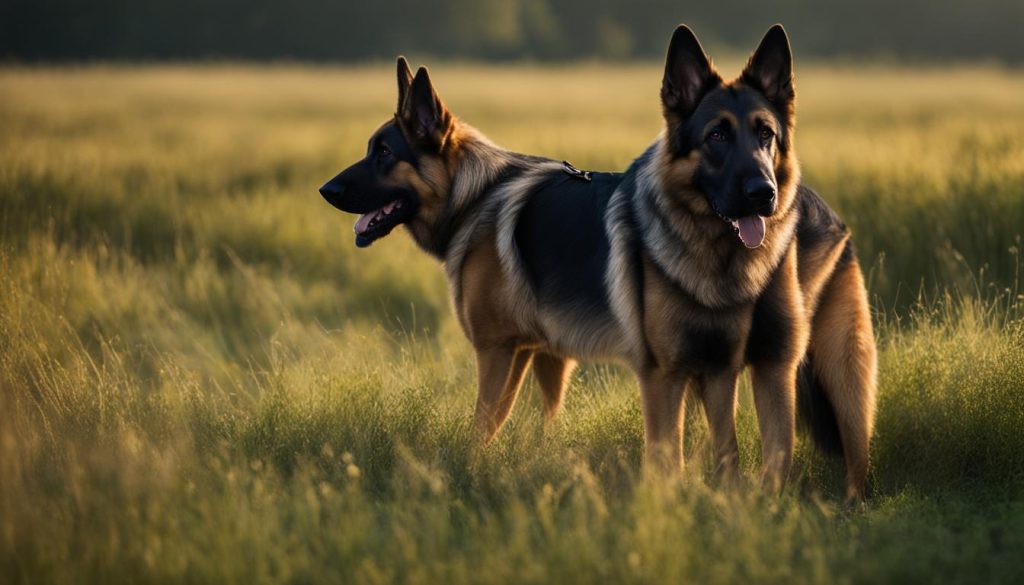
Final Thoughts
Understanding German Shepherd types is essential when considering this versatile breed. With different types of German Shepherds available, each with its own unique characteristics and purposes, choose the right fit for your lifestyle and needs.
Whether you are interested in show lines or working lines, there is a German Shepherd type that will suit your preferences. Show lines, such as the American show lines and Canadian show lines, prioritize conformation and are ideal for dog shows. On the other hand, working lines like the West German working lines, DDR/East German working lines, and Czech working lines excel in sports, working jobs, and positions of service.
Additionally, German Shepherds come in different coat colors, adding to their distinctive features. From saddle colored German Shepherds with their black and tan coats to black German Shepherds with variations like liver or blue, and even rare solid white German Shepherds and sable German Shepherds with their unique color patterns.
By understanding the various types of German Shepherds and their specific traits, you can make an informed decision and find the perfect German Shepherd that matches your preferences and lifestyle.
FAQ
What are the different types of German Shepherds?
The different types of German Shepherds include American show lines, Canadian show lines, West German show lines, West German working lines, DDR/East German working lines, Czech working lines, and various mixes of lines.
What are American show lines?
American show lines are German Shepherds bred to conform to the standards set by the American Kennel Club. They prioritize conformation and side gait, making them suitable for dog shows.
What are Canadian show lines?
Canadian show lines are German Shepherds bred to adhere to the standards set by the Canadian Kennel Club. They prioritize conformation and side gait, making them ideal for dog shows.
What are West German show lines?
West German show lines are the most popular type of German Shepherd in Germany. They conform to the standards set by the German Shepherd Dog Club of Germany (SV) and emphasize health clearances, working titles, and a specific black and red saddle back “look”.
What are West German working lines?
West German working lines are German Shepherds bred to prioritize correct working structure, solid temperament, and strong working drives and abilities. They excel in sports, real working jobs, and positions of service.
What are DDR/East German working lines?
DDR/East German working lines are German Shepherds developed in East Germany. They are known for their correct working structure, large heads, large bone, and dark pigment. They have distinctive genetics and temperament.
What are Czech working lines?
Czech working lines are German Shepherds that originated in Czechoslovakia and were built on a foundation of working dogs used for border patrol work. They are known for their intense, agile working abilities and high working drives.
Are there German Shepherds that are a mix of different lines?
Yes, some German Shepherds are the result of various mixes of lines, combining traits from different types of German Shepherds.
What are the differences between working line and show line German Shepherds?
Working line German Shepherds are stronger, more energetic, and require a significant investment of time and energy. Show line German Shepherds are friendlier, require less time commitment, and are often chosen as family dogs.
What are the different coat colors of German Shepherds?
German Shepherds come in various coat colors. Saddle colored German Shepherds have a tan or red coat with a black saddle or blanket pattern. Black German Shepherds can have variations such as liver or blue in their coats. White German Shepherds have a solid white coat. Sable German Shepherds have a color pattern spread throughout their body, starting as tan and becoming stronger as they age.
What is the conclusion of understanding different types of German Shepherds?
German Shepherds are a versatile breed with various types, each with its own characteristics and purposes. I recommend that you understand the different types to find the right fit for your lifestyle and needs.


